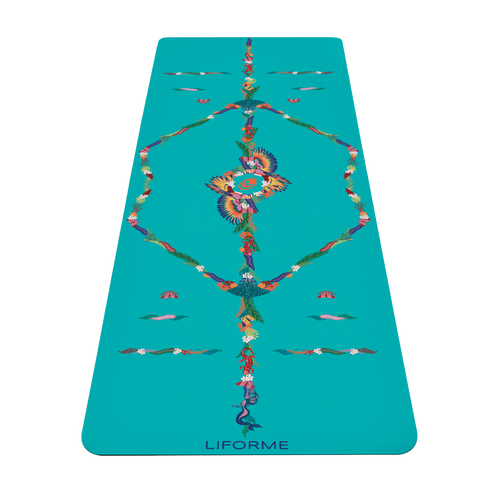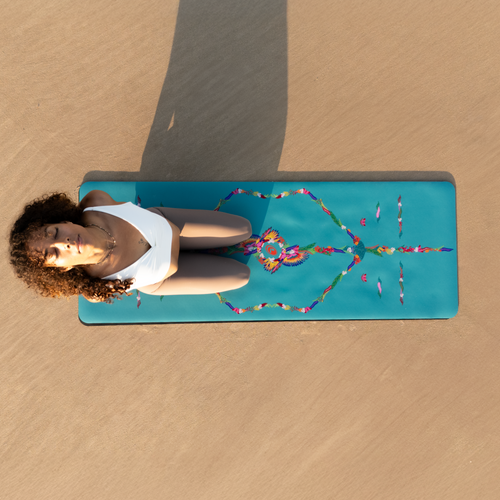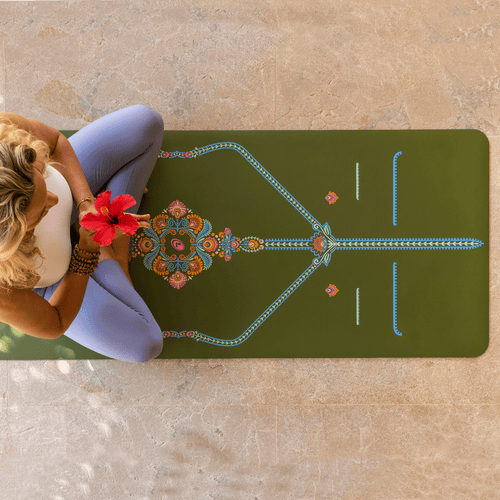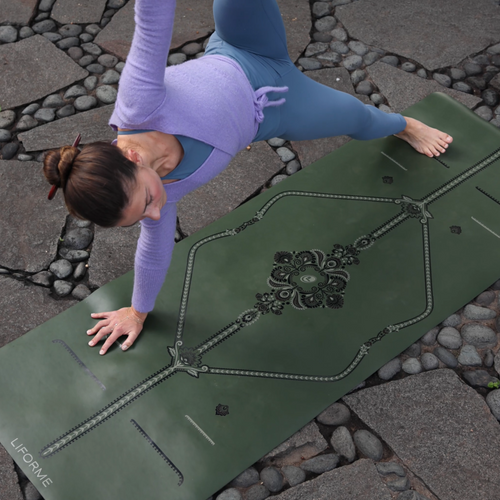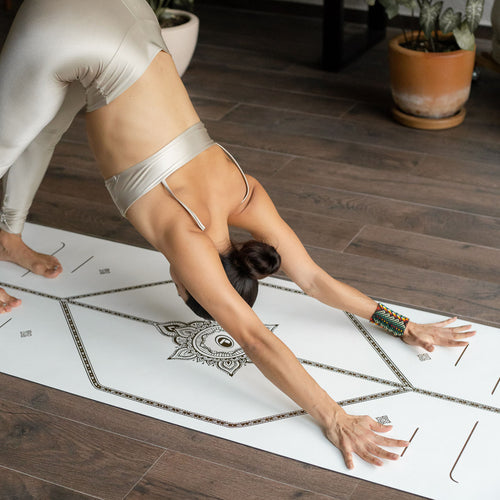Self-love is a bit of a buzzword in the wellness community, which means we hear a lot of talk about the importance of accepting and loving ourselves, but not a lot of useful advice on how to get there.
It’s very difficult to wake up one morning and decide you’re finally going to start loving yourself. But, you can wake up today and decide to do yoga.
Poses to Connect to Your Body
Fully inhabiting your body through grounding practices like movement and breath help you feel more comfortable in your skin. An appreciation for yourself grows as you discover what you are capable of and how to be in the present moment. As you learn to feel more connected to all the different parts of your being, your love for yourself naturally grows.

Mountain Pose (Tadasana)
Sanskrit Meaning: Tada (mountain) Asana (pose)
Yoga Level: Beginner
Pose Type: Standing
Benefits: Promotes good posture. Strengthens the legs and core. Improves your body awareness.
Why this pose: Mountain Pose provides the opportunity for a full body check-in as you ground through the soles of your feet.
Step-by-Step:
- Come to stand at the front of your mat with your feet parallel.
- Feel all four corners of your feet root into the floor.
- Engage your quads to lift your kneecaps.
- Draw your navel gently toward your spine.
- Stack your shoulders over your pelvis.
- Open your palms toward the front of the room.
- Keep your chin parallel to the floor.
- Close your eyes as you focus inward on the sensations engaging your whole body.

Corpse Pose (Savasana)
Sanskrit Meaning: Sava (corpse) Asana (pose)
Yoga Level: Beginner
Pose Type: Supine
Benefits: Rests the body
Why this pose: Connect with yourself as you acknowledge and relax each part of your body.
Step-by-Step:
- Come to lie on your back. We often end class this way, but you can also begin here.
- Bring your attention to your toes and then relax them. You can also try engaging them and then relaxing them.
- Bring your attention to your feet, then your calves, knees, and thighs.
- Move on to your buttocks, abdomen, shoulders, arms, hands, and fingers.
- Finish with your face.
- Spend several breaths fully relaxed after having recognized every part of your body.
Poses to Accept and Love Your Body
One of yoga’s most powerful lessons is to accept your body where it is on any given day. When you first start yoga asana practice, that doesn’t always come easily. You may struggle to arrange your body to resemble the poses you see demonstrated at the front of the room. You can’t force or sweet-talk your hamstrings into a deeper forward bend, so you have to accept yourself as you are.
With consistent practice, you may soon start to see improvement, and that makes you feel good about yourself. You’ve done something difficult, and your body and mind have experienced change. If you’ve struggled with your body image, your negative feelings about how your body looks may even be replaced with positive ones about what it can do.
In yoga, there is no end goal, no place where you can stop and rest on your laurels, at least not for very long. There will always be another challenge and other opportunities to repeat the cycle of trying, failing, doubting yourself, and overcoming.
Eventually, you may come to see that the failing and the doubting are not the most important part of the process. Actually, neither is the overcoming. Trying and trying and trying some more is the practice. It’s much more difficult to see yourself as a failure when it's revealed how irrelevant success is.

Standing Forward Fold (Uttanasana)
Sanskrit Meaning: Uttana (intense stretch) Asana (pose)
Yoga Level: Beginner
Pose Type: Standing
Benefits: Stretches your hamstrings and back, strengthens your legs.
Why this pose: Uttanasana is an opportunity to practice acceptance. It feels good to forward bend; how deep you go doesn’t matter.
Step-by-Step:
- From Mountain Pose, rotate your pelvis forward to come into a forward fold on an exhalation of breath.
- Keep your pelvis stacked over your ankles.
- Let your arms and your head hang heavy.

Wind Relieving Pose (Pavanamuktasana)
Sanskrit Meaning: Pavana (wind) Mukta (liberating) Asana (pose)
Yoga Level: Beginner
Pose Type: Supine
Benefits: Compression of the abdominal organs.
Why this pose: Give yourself a hug to affirm your self-love.
Step-by-Step:
- Lie down on your back with your knees bent.
- Lift your feet off the floor and hug your knees into your chest, wrapping your arms around your shins.
Poses to Free Your Mind
Yoga and meditation teach us how to be in the present moment. Think about the negative self-talk that happens in your head. You’re beating yourself up over something that happened in the past or stressing over something that’s coming up in the future. But what about right now? What are you doing right now?
When you’re meditating, you’re sitting and breathing. When you’re deep in a yoga pose, your body takes a different shape, but you’re still just breathing. Inhaling. Exhaling. Inhaling. Exhaling.
The breath provides a refuge where you can hold the past and the future at bay and stay in the present, even if it’s for just a few moments. And this handy tool is always with you, available at any time.

Chair Pose (Utkatasana)
Sanskrit Meaning: Utkata (powerful) Asana (pose)
Yoga Level: Beginner
Pose Type: Standing
Benefits: Strengthens your legs and core
Why this pose: When your thighs start burning, focus on your breath.
Step-by-Step:
- From Mountain Pose, bend your knees while taking your butt toward the back of your mat as if you were going to sit in a chair.
- It doesn’t matter how deep you sit as long as you feel it in your thighs.
- Take your arms overhead.
- Breathe through your discomfort for 10 breaths.

Easy Pose (Sukhasana)
Sanskrit Meaning: Sukha (comfort) Asana (pose)
Yoga Level: Beginner
Pose Type: Seated
Benefits: Opens the hips, improves posture.
Why this pose: After your asana session, practice sitting for meditation for five to ten minutes.
Step-by-Step:
- Come to sit in a comfortable, cross-legged position. If your knees are higher than your hips in this position (they are for most people), take folded blankets or blocks under your seat until your knees are below your hips. This makes it much easier to keep your spine long.
- Bring your hands to your thighs with your palms facing up or down.
- Close your eyes.
- Focus on your inhalations and exhalation of breath: how it feels to fill and empty your lungs, what the air feels like going in and out of your nose.
- When your mind wanders and you start to engage with your thoughts, catch yourself and refocus on your breath.
Poses that Introduce Body to Mind
Releasing tightness and making space in the body are big parts of the physical practice of yoga. But it’s also about making space in your mind. The extreme physicality of asana practice (which doesn’t mean circus-style acrobatics; it means the sharp focus and minute attention to detail that aligning your body into any yoga pose requires) has the effect of temporarily emptying your mind.
When you come back, you might find that things have been rearranged. Your negativity and self-doubt may have moved over to make room for your positivity and self-love. It doesn't happen overnight, but with consistent practice, it does happen.

Tree (Vrksasana)
Sanskrit Meaning: Vrksa (tree) Asana (pose)
Yoga Level: Beginner
Pose Type: Standing
Benefits: Improves balance, core strength, and leg strength.
Why this pose: Balancing poses that require a lot of attention to alignment help clear your mind.
Step-by-step:
- From Mountain Pose, begin to take your weight into your right leg without changing the neutral position of your hips.
- Lift your left foot away from the floor.
- Position the sole of your left foot on your inner right thigh, using your hands if necessary. It’s also ok to take the left foot lower on your right leg if it doesn’t comfortably come to the thigh.
- Press your foot into your thigh and your thigh back into your foot.
- Take your arms overhead.
- Keep your attention focused on maintaining your alignment and your balance.
- After several breaths, repeat standing on the other leg.

Warrior II (Virabhadrasana II)
Sanskrit Meaning: Virabhadra (a Hindu warrior) Asana (pose)
Yoga Level: Beginner
Pose Type: Standing
Benefits: Strengthens the legs, back, arms, and core. Opens the hips, hamstrings, and chest.
Why this pose: Attention to detail improves your body awareness, integrating body and mind.
Step-by-Step:
- From Mountain Pose, step your left foot to the back of your mat.
- Turn your left toes out 90 degrees and align the heel of your right foot with the arch of your left foot using the Central Line on your mat.
- Bend your right leg to bring your knee over your ankle and right thigh parallel to the floor.
- Align your hips and shoulders with the long side of your mat, stacking your shoulders over your hips.
- Take your arms parallel to the floor and your gaze over your front fingertips.
- Repeat the pose with the left leg forward.












